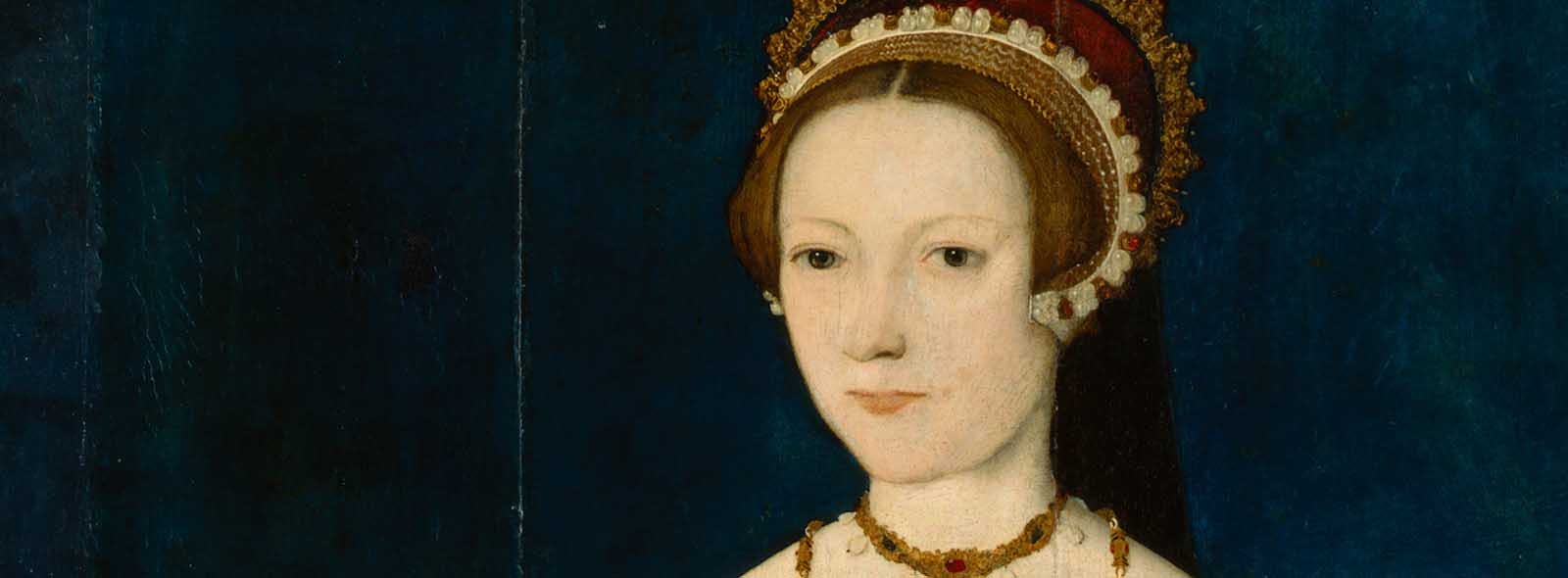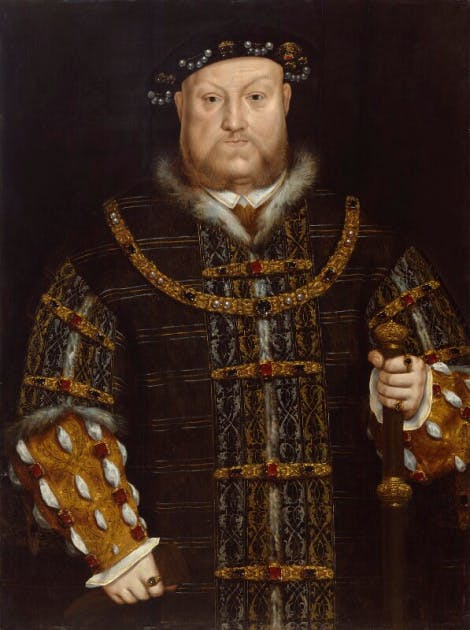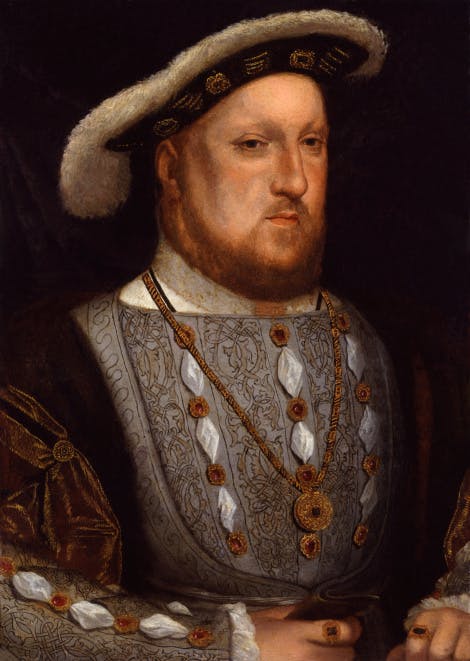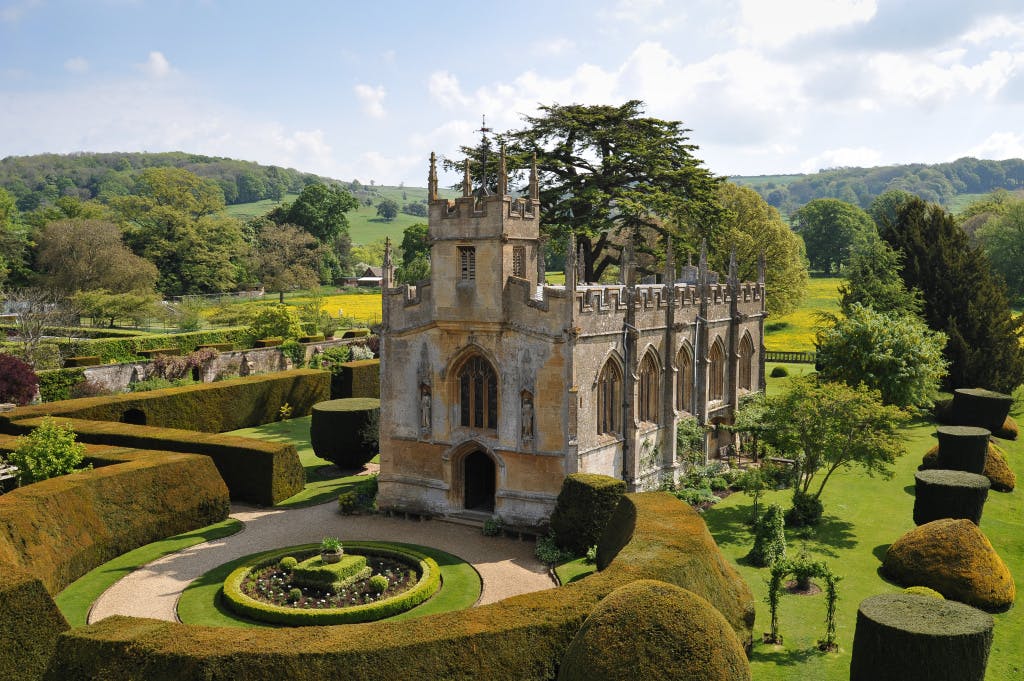
The Remarkable Life of Henry VIII’s Last Queen
The Magic Garden is closed 02 January 2026 due to adverse weather conditions.
Katherine Parr was Henry VIII's sixth and final wife. Though cast by some historians as the King's saintly nurse, Katherine was an energetic and passionate Queen Consort — a published author, loving stepmother, and outspoken supporter of the English Reformation.
Katherine married Henry in the Queen's Closet at Hampton Court Palace and was his Queen for three and a half years. She served as Regent-General while the King waged war in France and helped reconcile him with his two daughters, Mary (the future Mary I) and Elizabeth (the future Elizabeth I).
But Katherine's influence and beliefs made her enemies at court. Henry’s last Queen not only outlived her husband to marry Sir Thomas Seymour, but also survived a dangerous plot to have her arrested for heresy.
Header image: Katherine Parr, attributed to Master John, c.1545. © National Portrait Gallery, London

Image: Katherine Parr, by an unknown artist, late 16th century. © National Portrait Gallery, London
'Katherine', 'Catherine', or 'Kateryn'?
Henry’s sixth Queen generally signed her name as 'Kateryn'. However, today she is better known as 'Catherine' or 'Katherine'. We refer to her as 'Katherine' with a 'K' to help distinguish from her predecessor, Catherine Howard.
Katherine's Early Life
Katherine Parr was the eldest surviving child of Matilda 'Maud' Green and Sir Thomas Parr. She was born around August 1512 and had two younger siblings named William and Anne.
Both of Katherine's parents were prominent at the Tudor court. Thomas served as a close courtier to the young Henry VIII and Maud as lady-in-waiting to Katherine of Aragon. The Parrs probably named their eldest daughter after Henry’s first Queen.
Sir Thomas Parr died in 1517, leaving Katherine's mother Maud to oversee his estates and bring up their children. Maud was a practical, independent woman who valued education and became an influential role model in the young Katherine’s life. As an adult, Katherine was fluent in French and Italian, as well as a student of Latin and Spanish. She was also interested in medicine.
Katherine Parr's First Marriage
In 1529 Katherine married Sir Edward Borough: she was 16 and he was 21. We know very little about this first marriage. She and her new husband lived in the household and on the estates of his father Thomas Borough, 3rd Baron of Gainsborough, in Lincolnshire.
Lord Borough was a passionate supporter of the Reformation, a religious movement that split the English church from the Pope in Rome. He also served as Chamberlain to Henry VIII’s second Queen, Anne Boleyn.
‘Lady Latimer’: Katherine’s Second Marriage
By the early 1530s, Katherine had lost both her mother Maud and her first husband Edward. While her siblings established themselves at court in the south of England, tradition has it that Katherine, now a young, relatively poor widow, stayed with family at Sizergh Castle in Cumbria, in the north of England.
By 1534 Katherine had married her second husband, the twice-widowed John Neville, 3rd Baron Latimer. The Nevilles were a powerful northern family and a prestigious connection for the Parrs. Katherine became fond of her second husband and settled into her new role as Lady Latimer, mistress of her household and stepmother to Neville’s two children.
In 1536, Katherine was caught up in the Pilgrimage of Grace, a popular northern uprising against the English Reformation. She and her stepchildren were imprisoned in their own home and Lord Latimer was captured by the rebels.
A religious conservative sympathetic to the rebels' cause, Lord Latimer tried to appease the King on their behalf. However, this only angered both sides and Katherine’s husband was nearly charged with treason.
Lady in Waiting?
After the Pilgrimage of Grace, Lord and Lady Latimer moved south, though Neville frequently returned north on behalf of the government. Katherine probably enjoyed being closer to her siblings in London, who both held prominent positions at the Tudor court.
Some historians argue that Katherine joined the household of Mary, Henry VIII’s eldest daughter, in the winter of 1542-3. However, this is still disputed. Nonetheless, Katherine’s family connections probably made her a regular presence at court.

Image: Thomas Seymour, Baron Seymour, by an unknown artist, 16th century. © National Portrait Gallery, London
Enter Sir Thomas Seymour: Katherine Falls in Love
By early 1543, Lord Latimer's health was failing, and Katherine knew she would soon be a widow once again. However, she wanted to remarry – this time for love.
Sir Thomas Seymour was the ambitious, roguish, and charismatic brother of Jane Seymour, Henry VIII’s third Queen. This made him the King’s brother-in-law and uncle to Prince Edward. Katherine was probably introduced to Thomas through her brother William.
Katherine fell in love. She later wrote to Thomas that 'my mind was fully bent the other time I was at liberty to marry you before any man I know'.
However, fate had other ideas. Little did Katherine know that she had also caught the attention of the King.
Katherine Parr meets Henry VIII
A year after his fifth Queen, Catherine Howard, was executed at the Tower of London, the now 52-year-old Henry VIII was still a widower. Elderly and increasingly immobile, Henry felt betrayed by Catherine’s infidelity and had reservations about marrying again.
However, Henry’s eye eventually turned to Katherine Parr. It’s unclear how Henry came across her. Observers reported on Henry’s frequent visits to his daughter Mary’s household in early 1543, where some historians place Katherine as a lady in waiting. However, he may have met Katherine through her husband or her siblings at court. Katherine is also said to have petitioned the King on behalf of her uncle Sir George Throckmorton in 1540.
Lord Latimer died in March 1543. Henry did not wait long to ask Katherine to be his new wife and Queen.

Image: King Henry VIII, by an unknown artist, based on a work of c.1542. © National Portrait Gallery, London
Katherine Parr: Saintly Nurse or King's Companion?
It is often said that the aging Henry married Katherine Parr because he needed someone to nurse him through his growing list of illnesses. However, while she was well versed in both medicines and marriage, Henry probably did not expect Katherine to become his nurse – he had his own doctors to attend him.
Instead, Henry saw the clever and outgoing Katherine as a potential consort and companion. In contrast to the teenage Catherine Howard, 30-year-old Katherine Parr was an older and experienced woman. During their marriage, he called her ‘sweetheart’ and trusted her with his children and his country.
And of course, Henry also hoped she would become a mother to another son and heir (though neither of Katherine’s previous marriages had produced children).
Did Katherine Parr want to marry Henry VIII?
At first, Katherine Parr did not want to marry Henry VIII. For starters, she was in love with Thomas Seymour. But Katherine also knew the fates of her five predecessors – all of Henry's VIII's wives had been so far either set aside, executed, or lost in childbirth.
However, it is not easy to refuse a King. Probably pressured by her family, Katherine decided that it was God’s will to accept the proposal.
Howbeit, God withstood my will therein most vehemently …. [and] made me to renounce utterly mine own will, and to follow his most willingly.
Katherine Parr on agreeing to marry Henry VIII

Image: The Lady Chapel at Hampton Court Palace. © Historic Royal Palaces
Katherine Parr Marries Henry VIII at Hampton Court Palace
Katherine Parr married Henry VIII on 12 July 1543, in the Queen’s Closet at Hampton Court Palace. It was a small, relatively private ceremony limited just to family and close friends - including Henry’s daughters, Mary and Elizabeth.
Katherine chose a crowned maiden with a Tudor rose as her emblem. Her motto read 'to be useful in all I do'.
A woman in my judgement, for virtue, wisdom and gentleness, most mete for his highness; and sure I am his majesty never had a wife more agreeable to his heart than she is.
Sir Thomas Wriothesley on Katherine Parr, 1543

Image: Katherine Parr, attributed to Master John, c.1545. © National Portrait Gallery, London
Portrait of a Queen
Painted in 1545, this stunning full-length portrait reveals Katherine as Queen. It also captures her love of rich fabric, fur, and jewels. One witness in 1544 described Katherine dressed in her signature red velvet and satin, offset with diamonds and cloth of gold – a vision of royal splendour.
For Katherine, clothes were more than a personal indulgence. She never expected to become Queen and most of her life had been spent as a northern noblewoman. By dressing the part, Katherine projected herself as a fashionable and respected consort. Katherine was also a prolific patron of portrait artists; paintings like this helped establish her image as a Tudor Queen.

Image: Elizabeth I when a Princess c.1546. © Royal Collection Enterprises Ltd | Royal Collection Trust
Katherine as Stepmother to Mary, Elizabeth, and Edward
One of Katherine’s triumphs as Queen was to earn the love and trust of the King’s three children: the Lady Mary, the Lady Elizabeth and Prince Edward.
Katherine was a warm and supportive presence in her stepchildren’s lives. As soon as she became Queen, Katherine encouraged the studies of 9-year-old Elizabeth and 5-year-old Edward, who both eagerly responded to her attention.
Katherine and Mary
Katherine became close friends with Mary. Connected through their mothers, the two women were similar ages with mutual interests in music and fashion. In 1544 Chapuys, the Spanish Ambassador, wrote that the new Queen ‘[favoured] the Princess in all she can’.
Katherine and Elizabeth
Katherine became particularly close with Elizabeth; four of the five surviving letters written before Henry’s younger daughter turned 16 were addressed to Katherine Parr. Sharing her interest in education and religious reform, Elizabeth later translated Katherine’s book Prayers or Meditations into French, Italian and Latin.
Some historians argue that both Mary and Elizabeth modelled their queenship on Katherine Parr — particularly Elizabeth. During the summer of 1544, during Katherine's Regency, Elizabeth spent time with her stepmother at Hampton Court. This experience would have an enduring impact on the young princess; for the first time, she visited a royal palace with a Queen, not a King, presiding over the court.
Mary and Elizabeth Restored to the Succession
Most importantly, Katherine helped bridge the gap between Henry VIII and his children. This reconciliation had huge implications for the Tudor dynasty. Reports from Henry’s court show that Katherine was a key player in Henry’s decision to restore Mary and Elizabeth to the line of succession – a choice that supported both women’s claims to the English throne.

Image: King Edward VI after Hans Holbein the Younger, c.1542. © National Portrait Gallery, London
Wherefore, since you love my father, I cannot but much esteem you; since you love me, I cannot but love you in return; and since you love the word of God, I do love and admire you with my whole heart.
Edward VI to Katherine Parr, 1547
Katherine as Diplomat and Regent-General
While Katherine played the diplomat in the King’s family at home, she also helped shape England’s allies abroad. Katherine’s friendship with her eldest stepdaughter fostered good relations with Mary’s cousin, the Holy Roman Emperor King Charles V of Spain, who instructed his ambassadors to stay on good terms with the Queen.
Katherine’s real test came in 1544 when Henry allied with Charles V and left to wage war in France. The King appointed Katherine as his Regent-General, empowered to rule in his name with the support of a carefully chosen regency council. For Katherine, this was a remarkable sign of Henry’s trust. She signed five royal proclamations as regent, supporting her husband’s war effort whilst overseeing domestic issues such as tensions on the Scottish border.
You are doing the right thing in keeping on good terms with the Queen... do not fail, whenever the opportunity offers, to address her.
Charles V to Chapuys on Katherine Parr

Image: A prayer book belonging to Katherine Parr, now on display at Sudeley Castle. © Sudeley Castle
A Religious Reformer and Published Author
By the time she became Queen, Katherine was a passionate supporter of religious reform. A keen patron of religious scholars, she enjoyed reading and discussing new reformist ideas. She even channelled these beliefs into writing books of her own.
Though Katherine’s early work was published anonymously, she produced two books in her own name. The first, titled Prayers or Meditations, was published in 1545. It included five original prayers and was the first work published in the name of an English Queen.
She later produced another book after Henry’s death called The Lamentation of a Sinner (1547). This was a self-reflective piece that explored more radical themes of sin, repentance and ‘justification by faith alone’ – the protestant belief that sin could not be forgiven by ceremony and charity on earth.
A Plot Against a Queen: Katherine Survives a Conspiracy
The last years of Henry’s reign were a dangerous time for religious reformers – even for a Queen. Many conservatives at court felt threatened by the prospect of further and ‘heretical’ protestant influence in the English church – including Katherine’s passionate interest in reform.
With the King’s health deteriorating and the underage Prince Edward set to inherit the throne, these factions fretted over Katherine’s influence on Henry, especially after her success as regent-general.
In 1546, Katherine’s situation took a turn for the worse when her enemies, led by Stephen Gardiner, Bishop of Winchester, took decisive action.
The King’s Bad Mood
The King was fond of his sixth Queen, but he was still a religious conservative at heart. He grew irritated with Katherine’s passionate debates about reform and revealed his frustrations to Bishop Gardiner.
According to John Foxe’s Book of Martyrs (1563), Gardiner and his co-conspirators jumped on the opportunity to implicate Katherine in heresy, and launched an investigation into the Queen and her ladies.
Search and Torture
Looking for evidence, the conspirators searched the rooms of Katherine’s ladies for radical religious books. They also interrogated Anne Askew, a protestant preacher who was imprisoned and tortured at the Tower of London.
Anne, who would later be burned at the stake for heresy, refused to implicate the Queen. Undeterred, Gardiner presented his evidence to Henry and secured a warrant for her arrest.
A Quick-witted Queen
By chance, Katherine’s allies glimpsed her arrest warrant and were able to inform her of the plot. The Queen immediately took to her bed and proclaimed she was terribly ill. Henry soon arrived at her bedside, where she asked if he was angry with her.
Katherine later promised that she only argued with Henry to learn from him and to take his mind off his illness and injuries. She was a ‘silly poor woman’ and the King was her ‘only anchor, supreme head and governor here on earth, next to God’.
Discreetly, Katherine had any incriminating books removed.
Katherine Survives
For once, Henry forgave his Queen. The couple were 'perfect friends again' and when men arrived to escort Katherine to the Tower of London, Henry furiously sent them away.
By carefully deferring to her husband, Katherine Parr had survived what many of her predecessors could not: a plot to remove a Queen from Henry's side.
Death of Henry VIII
Henry VIII died at Whitehall Palace on 28 January 1547, aged 55. Edward Seymour, Duke of Somerset and uncle to the new King Edward VI, was named Lord Protector. Firmly excluded from her stepson’s regency, Katherine set about deciding her own future.
Life After Henry
In early 1547 Katherine reconnected with Thomas Seymour, now uncle to the new King and brother to the Lord Protector. In May, the couple married in secret without Edward VI’s permission. This was a provocative move that damaged Katherine’s relationship with Edward and Mary, who felt it was disrespectful for her to marry so soon after their father’s death.
However, Katherine remained on good terms with Elizabeth, who she invited to live with her and Seymour. However, Seymour was a poor guardian for the young princess. He began harassing Elizabeth, visiting her bedroom in his night clothes. Seymour was even caught with his arms around the young princess. In 1548, this inappropriate relationship led Katherine to send Elizabeth away – both to protect her own marriage and preserve Elizabeth’s reputation.

Image: Katherine Parr's tomb in St Mary's Church at Sudeley Castle. © Sudeley Castle
The Death of Katherine Parr
In December 1547, Katherine became pregnant. The couple were excited to welcome their first child, but Seymour worried about Katherine’s health and hoped the baby would be small to ease her labour. Both Mary and Elizabeth wrote to ask anxiously after their stepmother’s wellbeing.
On 30 August 1548, Katherine gave birth to a daughter. The delighted couple named the baby Mary, probably after Katherine’s dear friend and stepdaughter.
However, the couple’s joy was short lived. Katherine contracted childbed fever and died on 5 September 1548, aged 36. Katherine was buried in St Mary's Church at Sudeley Castle in Gloucestershire.
What happened to Katherine Parr's daughter?
In 1549, the ambitious Sir Thomas Seymour was executed for treason, leaving Katherine’s daughter an orphan. The two-year-old Lady Mary Seymour disappeared from the historic record in around 1550.
Katherine Parr’s Legacy
Katherine Parr was married to Henry VIII for three and a half years. In such a short time, she left an undeniable impact both on the royal family and the future of the Tudor dynasty.
The first English Queen to publish a book in her own name, Katherine’s writings illuminate the religious convictions that nearly cost her everything. By reconciling Henry with his children, Katherine helped lay the foundation for both Mary and Elizabeth’s succession to the throne and served as a vivid, personal example of what it meant to be a Tudor Queen.
Listen to the podcast
The Six Tudor Queens: Katherine Parr
Was Katherine Parr the nursemaid who looked after and survived her husband, or was she much more than that?
In this final episode of our The Six Tudor Queens podcast series, Tracy Borman and historian Sarah Gristwood acquaint us with the woman behind the myths, an intelligent, strong and resourceful champion of her own agenda.
Podcast Transcript
Browse more history and stories

Henry VIII’s wives: six queens, six women
These six queens consort all had one man in common. But is it possible to understand them as individuals, even after 500 years?

Henry VIII, Terrible Tudor?
Who was the real Henry VIII?

The Field of Cloth of Gold
Henry VIII's historic meeting with his great rival François I in 1520 was a defining point in his reign
Explore what's on

- Families
- Half term
- Things to see
February Half Term
Join a royal quest this half term with Elizabeth I at Hampton Court Palace.
-
14 – 22 February 2026
- 10:00-16:00
- Hampton Court Palace
- Included in palace admission (Members go free)

- Things to see
Hampton Court Gardens
Take time to explore and relax in these world-renowned gardens and find our free entry Garden Open Days dates.
- Open
- In line with palace opening hours
- Hampton Court Palace
- Included in palace admission (Members go free)

- Things to see
Pond Gardens
Discover the sunken gardens created for Henry VIII and transformed by Mary II.
-
Open
- In line with palace opening hours
- Hampton Court Palace
- Included in palace admission (Members go free)
Shop online

Katherine Parr Decoration
Handmade fabric hanging decoration of Katherine Parr, King Henry VIII's six wife.
£13

Christmas homepage banner - Henry VIII and Six Queens Decoration Set
Christmas Homepage Banner - Henry VIII and Six Queens hanging decoration set on a Christmas tree at Hampton Court Palace.
£70.00

Shop Tudors
Find the perfect gift for collectors and history enthusiasts in our treasure trove of souvenirs inspired by this ever-fascinating dynasty.
From £3.00

